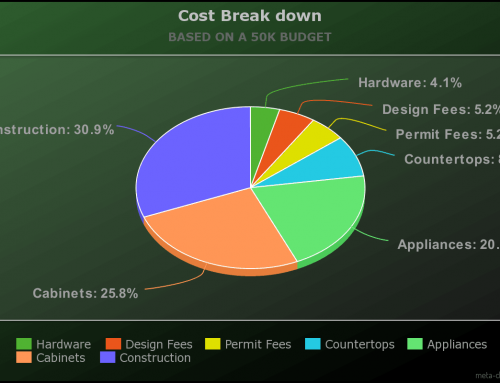
RAJ Kitchen and Bath
What is a change order? and can I avoid them?
The undertaking of a Kitchen and Bath remodel is a daunting task. It’s not the same as calling over the landscaper to cut the grass this month. Come to think of it, some clients’ yard is so complicated that it needs a Horticulturist, an Arborist, a Botany and an Arbor culturist just to maintain it…We think you get the idea. With a remodel, there are hundreds of moving parts that all have to come together as one in order to have a successful remodel. In this case, the Kitchen space is one of, if not the most important remodel that you would do in your home. Still to this day it hangs on for the top spot as most valuable spaces to renovate because of the most return you’ll receive according to the Cost Vs value data. On the flip side, it is also the one area where you can run over cost like a hot knife through butter! We see where it happens time and time again; which is a little-known pesky phrase or line item called Change Orders.
What are change orders? Simply put, change orders are additional cost that are incurred on a project after the contract was signed and work is “typically” already on the way. Change orders can be triggered by the contractor for example: he opens up the wall and find a HVAC or Plumbing Stack pipe that has to be relocated. So now he has to call in his HVAC/Plumber sub to re-route and or relocate that pipe, and you would in-turn be billed for that extra cost.
Change orders can also be triggered by you the client. For example; Instead of sticking with initial Paint palette, you change it after its already been applied, so you ask the contractor to repaint the room or even the house, because you now no longer like the color, or the floors or whatever it is that was already agreed upon. Swapping out a window or a door after its installed, lighting fixtures, cabinets, tiles etc; that was already done or delivered to site or already been bought or budgeted for, and now you ask that it be returned, re-ordered and redone. This will typically trigger a change order.
Change orders can get messy real fast, this does have the potential to ruin the relationship between contractors and clients. I’ve seen contractors weaponize change orders for their own benefit. Here is how a scenario like that could work. They would give a bid on a Job. A low-ball bid on a set of incomplete plans, they would know that the plans does not have enough information to get you an accurate number but they would go as low and as basic as it is. Then when they are on the job, they tell you something like this. “Ohh Mrs. Jones, your refrigerator is connected to a shared outlet and my electrical guy said that it has to be a home run to meet code, not only the refrigerator, but all of them” Mrs. Jones get shocked and upset but Mrs. Jones would pay the additional 1000.00 since each home run is about 200.00 and we have to cut there, patch here, blah blah blah… Any contractor who is worth his weight in gold knows, that once you are bidding on a full kitchen remodel, especially if it’s an old house, that you must budget for and plan to do home runs for each appliance that is in the kitchen.
It’s a silly example but you get the point. Now you are stuck because now you want get the work done and so you pay. Is it a legitimate work order? yes, it’s a code requirement in most states and it has to be done. Should this have been on the original estimate before you started the work? Yes, if they knew what they were doing or was it an intentional stunt? To this old trick “we go in low, get the Job, get in the door and catch up on the difference using change orders”
On the other side of that spectrum, I see where some contractors would spend thousands of dollars doing additional work which should have been change orders, but they were afraid to ask for the change in cost and sometimes, they are hoping that the client would see and appreciate the additional work and reward them for it. The hope is that the client would recognize the additional work and say thank you or give them a rave review online, while they go out of business. During one of our round table discussion a few years back, a contractor on the panel said that he does not like to upset the client so they would typically handle change orders to keep the work moving and keep the client happy.
Change orders are one of those dirty word that; if not handled correctly, open and upfront, can make even the best executed Job leave a bitter taste in the client’s mouth.
Can I avoid change orders? My professional answer is maybe. Sorry but eventually, we are who we are and we want what we want. Imagine you picking out a paint color that looks beautiful in the store but looks horrible against all of your decorative finishes in your house? If the GC said it’s an additional $300.00 for you to repaint and get the color of your dreams would you do it? What if that long awaited open concept kitchen is finally a reality only to find out that there is a post in the way that can be move but it’s an additional $2500.00? for $2500.00 would you walk around a post in the middle of your kitchen or would you look at that unobstructed view of that back yard or lake or living room?. Can I avoid change orders? my answer is maybe if you cannot afford it.
Here are some recommendations that you can do to try to reduce the chances of a change order or mitigate against them.
- Choose the right team! Good designers, Architects and contractors cannot see through walls but they can come pretty close. A good designer would design and anticipate some unforeseen trouble that you would run into even before you get into it, hence they can plan the remodel around the unforeseen. They are not always right, but it can save you a bunch of headaches. You either pay a fee now to get a good solid design team wraps around you or you pay the changes later when you realize that you already order those expensive cabinets and appliances only to find out that they would not fit.
- DO NOT go to the bidding process unless you have a complete set of plans. A complete set of plans is relative to the extent of the remodel that you are going to do. If you are simply going to replace cabinets, you probably should have stop reading this article about 4 paragraphs ago. Too many clients send out rough plans to contractors and find themselves with the lowest upfront bid but ended up with the highest project cost by the time they get the C.O (certificate of occupancy)
- Your overall cost is not the cost of the cabinets and construction. On our website, we posted a pricing guide for more information but your cost if your TOTAL COST. Do not forget your, Architectural fees, design fees, permit fees, tiles, knobs, appliances, decorative lights, fixtures like your faucet, things like an Insinkerator, an expensive farm sink? All those pretty little things can really catch you off guard, if their installation procedures are not “typical”
- Finalize your appliances and their specification before the mechanical and electrical are “rough in”. For example, some refrigerators specifically have their plugs at the top not the bottom. If your electrician already run in your lines and then have to change it now because you want to get a different refrigerator, that just an example, its not as bad as the gas range. Some high-end gas range has the gas pipe shut off valve in the back of the unit at a specific precise location. If it is not there, the range would NOT sit up against the back of the wall. Imagine having the plumber coming back to relocate the pipe after he already pass inspection and do a gas pressure test? This can cost you. To avoid these silly mistakes. Get the appliance specifications. The actual appliance does not have to be on site as yet but the installation specifications should be there for all to see.
- Trust the process. Trust the people you hire to do the job. Trust that they would do what is necessary and right by you in order to pull off what is on the plan. Trust is a scarce commodity word these days but if you keep going on the site and keep asking to change, to add, to modify, you are essentially asking for change orders.
- Avoid the patch up team whenever you can. Patch team is the perfect set up for the blame game. If the electrician is a guy you know and is not the one working the general team at your house, the GC can always blame him/her about not doing something or doing something wrong that has to make him cut out some walls that wasn’t necessary so that now you are starring down the barrel of a change order. Deal with one team whenever possible.
This was no doubt a long article, but we are breaking the mold! We want to let you know as much as we can. I assume that you got here to the bottom of this article because you are probably contemplating your next remodel. We can help. We do not like change orders. We try to avoid them whenever possible. We achieve this by doing a lot of the trouble shooting on the design table both with the design and construction team long before we go to production. It’s takes a lot of planning, using the “what if it is this… then we do that” type of thinking and strategizing but we do that to preserve the client budget and relationship whenever possible. Information is key. Honesty is critical. It is woven into our DNA, having open frank conversations helps us help you.
We would love to hear from you!






Leave A Comment